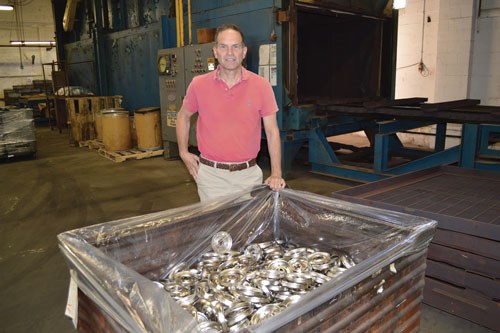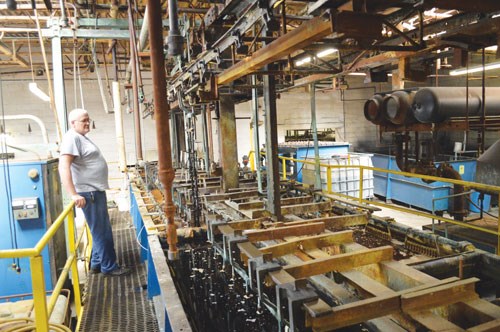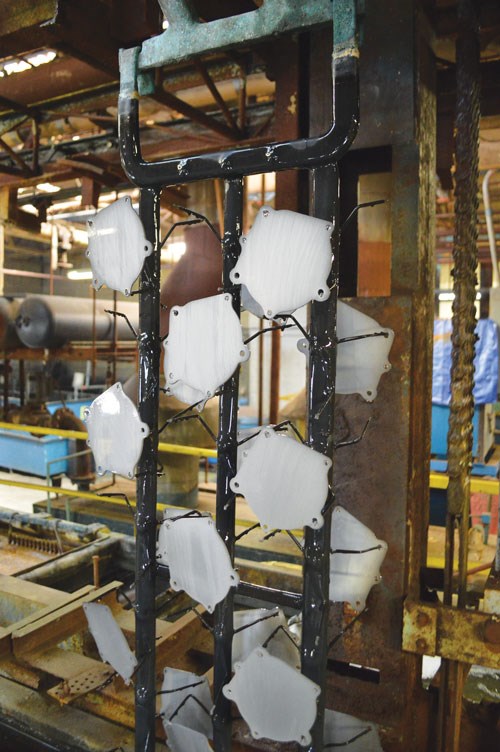Zinc-Nickel Teaches Experienced Plater New Tricks
"Old Dog" Micro Metal Finishing loses one line, gains another with help of chemical supplier.
Up until a warm day in June of 2013, Micro Metal Finishing owner John Rose’s company was plating thousands of washing machine parts a week for a major appliance manufacturer, just up the highway from his Cincinnati plant.
Then the phone call came, and things changed drastically for his business.
“Just like that,” says Rose. “They called and said they were changing their processes, and they didn’t need to nickel chrome plate that part anymore.”
It’s a phone call hundreds of plating shops across the U.S. get every day—lost business, through no fault of their own.
Micro Metal had an entire plating line dedicated to the washer machine parts, and the next day things started winding down. But you won’t hear Rose complain about his customer.
“We benefitted for several years when they moved that plating work down from Michigan to us,” he says. “It happens sometimes. There are no hard feelings because they were a good customer to us. But it didn’t hide the fact that I had a plating line that stopped that quickly.”

John Rose, owner of Micro Metal Finishing, had an entire plating line dedicated to washer machine parts go awat when the customer changed the part.
Unfortunately, the line was set up to exacting specifications from the customer—such as shrinking the chrome tanks and some other modifications—so that putting a different customer into the line would be difficult, to say the least.
“On this line we went from 100 percent appliance parts, to zero percent of anything else,” Rose says. “It wasn’t almost overnight; we had a few weeks to close it up and finish parts, but there wasn’t enough time to get another customer in to replace it right away.”
Big Changes
Obvious changes came to mind as Rose and his company sorted out what they needed to do, which was find a way to get the line back up and running. There were some layoffs of personnel, and a few veteran supervisors decided to retire, all gut-wrenching to Rose, but it was just another survival test for Micro Metal Finishing, which has been plating since 1951.
Its mainstay was decorative chrome, Rose says, and the company got its start when it began plating seatbelts that were sold through the Sears catalogue to consumers whose vehicles did not come with that safety equipment.
The shop has weathered significant changes in its customer base over the years—mainly automotive and some other safety fixtures—so it was back to the drawing board for Rose and his staff after their largest customer and almost half the sales pulled out.
It was at about the same time that Columbia Chemical—now one of Micro Metal Finishing’s main chemical suppliers—was starting to see a resurgence in the use of zinc-nickel for automotive coatings.
Brett Larick, president of Columbia Chemical, says that about 15 years ago, a large amount of zinc work left the plating industry and went to the organic side of the coating industry, such as paint, zinc flake/dip-spin, powder coating and electrocoating.

The industry is seeing more need for zinc-nickel, says Columbia Chemical President Brett Larick, especially in the assembled components such as fasteners, brackets and lighting.
But in recent years, the work is shifting back to the plating side, he says, with zinc-nickel becoming more popular—again—in the automotive industry.
“We are seeing a lot more need for zinc-nickel, especially in the assembled components such as fasteners, brackets and lighting components,” Larick says. “The main reason is basic corrosion protection; zinc-nickel just gives the OEMs a better product.”
Better Protection
Although organic coatings can consistently provide more than 1,000 hours of salt spray protection, Larick says the automotive industry saw issues arise once the components were assembled and scratches were occurring in process, such as with bolts and nuts.
“Once a part gets scratched, that 1,000 hours gets cut down considerably,” he says. “It became a real concern for the automotive industry and others who really needed that stringent corrosion protection.”
Tests done by numerous labs and suppliers found that a scratch on a zinc-nickel component dropped the salt spray protection by less than 10 percent, which is considered tolerable, Larick says.
“It was a 40 to 50 percent drop on the organic coatings,” he says. “That raised some eyebrows, and we started seeing the shift back to the plating.”
So when Micro Metal Finishing began to assess what to do with its now quiet plating line, it connected with Columbia Chemical on the idea of converting the nickel chrome line to a zinc-nickel line to take advantage of that automotive demand.
The concept was inviting for Rose, especially since he could lose the hexavalent chromium tanks and the regulations that come with it, and move to a coating that seemed to be on a growth spurt.
In fact, Rose says estimates are that zinc-nickel plating market is growing at about 20 percent a year.
“Zinc is the workhorse that is out there now,” Rose says. “And zinc-nickel is just an awesome alloy combination. Our zinc-nickel parts achieve 1,400 to 1,800 hours of salt spray; it is just an unbelievable alloy combination.”
ARL Tests
In tests conducted by the Army Research Laboratory at the Aberdeen Proving Ground in Maryland in 2010, electroplated zinc-nickel components that were post-treated with a trivalent chromate rinse from the production lines of a German automotive manufacturer showed that “performance under accelerated corrosion conditions far exceeded expectations.”
The study, conducted by Chris Miller, Brian Placzankis and Carl Handsy for the ARL, included parts—ranging from brackets to fluid lines and threaded couplers—that were rack or barrel plated with 0.2 – 0.5 mil zinc/nickel, zinc or zinc/iron and post-treated with a version of tri-chromate process (TCP-MIL-DTL-5541,1 Type III) and were randomly taken from the assembly line floor of an automotive plant in Germany.
The parts were exposed to standard 5-percent NaCl salt fog, and samples were examined for red rust on any surface. Once rust appeared, samples were removed and the exposure time noted, the study authors said.
The results astonished even the researchers, who noted that “better than half of the parts exposed to ASTM B 117 survived beyond 5,000 hours. Nearly half of the parts survived beyond 400 cycles of GM 9540.”
Micro Metal Finishing began a six-month process of converting the line, which included expanding tanks, reconfiguring processes and testing with Columbia’s chemicals. Rose even brought some of his former employees—some who had retired years earlier—back to help reconfigure the line because of their expertise on how it was built and configured originally.
“We first had to move the tanks around for the new configuration, then it was a process of re-lining the tanks and getting the rectifiers and ventilation modified,” Rose says. “We were dead in the water as far as utilizing this equipment, so we knew we had to get it done right and working properly.”

Micro Metal follows the zinc-nickel plating process with a clear or black passivation layer, and then applies a high corrosion-resistant sealer.
Appearance Battle
Micro Metal Finishing was already plating zinc, zinc iron and nickel, all of which are more functional coatings as well as decorative nickel chrome. At one time the company had been almost entirely in the decorative market, but Rose was increasingly concerned with what he calls an “appearance battle,” the insane standards that were often applied in that market.
“It was really getting out of hand because there isn’t any true standard in appearance, which is routinely at about 50 centimeters, or an arm’s length,” he says. “But I came to learn arm’s length was about two inches from your eye, with a magnifying glass. Some companies were using 200 and 400 percent inspections. Obviously, you want all of your work to look good, but it’s hard to compete in a high-wage country where repeated inspection of product is the norm.”
The decision to go with zinc-nickel was in line with the company’s goal of expanding functional coatings, so Micro Metal Finishing moved at a rapid pace with Columbia Chemical to get the line dialed in and ready for a new customer.
Larick says that Micro Metal was one of the first U.S. platers to use Columbia Chemical’s new Colloy Ni-Z-Posit-II chemistry, which is an alkaline non-cyanide plating process for electroplating a 12 to 15 percent zinc-nickel deposit.
“It’s a really good fit for engine compartment and braking system components where high in-service heat resistance and increased corrosion protection are needed,” Larick says.
Colloy Ni-Z-Posit-II chemistry was engineered to provide corrosion resistance of more than 1,000 hours, even after hydrogen relief baking. Larick says it readily accepts clear, iridescent, blue and black trivalent passivate technologies, while at the same time providing significantly brighter deposits with improved efficiency and easy-to-control alloy distribution.
“The overall goal with Micro Metal Finishing was to give them better plating speed and brightness,” Larick says. “The industry standard is that 12 to 15 percent nickel in the deposit, so we had to make sure there was a consistency there, too.”
Meeting Goals
The two companies met their goals. For Micro Metal Finishing, work from an automotive OEM came shortly after the system went online, much to the glee of Rose, who sweat through a few months of a non-performing line and the expense of a line conversion.
The shop’s high-capacity zinc-nickel line churns out zinc-nickel coatings on more than 350 racks of automotive components per shift. The zinc-nickel plating process is followed by a clear or black passivation layer to further increase corrosion resistance, and then a high corrosion-resistant sealer is applied.
In addition, Rose says his shop is doing some prototype work for a few other automotive OEMs that could result in even more work for his shop.

The zinc-nickel plating racks enable Micro Metal Finishing to plate parts up to 50 inches long and 15 inches wide.
“Unfortunately, the lag could be about 15 months before you ever start to see any new work come into the shop after these prototypes,” he says. “There is a long period where it may not come to fruition, but you have to keep talking to people and working with them.”
The zinc-nickel plating racks enable Micro Metal Finishing to plate parts up to 50 inches long and 15 inches wide. The company also has X-ray analytical capabilities to ensure it meets the proper plating thicknesses, as well as the critical zinc-nickel ratio.
Rose sums up his company’s recent experience of losing one line, yet gaining another, with a bit of self-deprecating humor. “Although our experience spans over half a century, Micro Metal Finishing is one old dog that is only too ready to learn new tricks,” he says.
Originally published in the August 2015 issue.
Related Content
3 Tests to Ensure Parts are Clean Prior to Plating
Making sure that all of the pre-processing fluids are removed prior to plating is not as simple as it seems. Rich Held of Haviland Products outlines three tests that can help verify that your parts are clean.
Read MorePossibilities From Electroplating 3D Printed Plastic Parts
Adding layers of nickel or copper to 3D printed polymer can impart desired properties such as electrical conductivity, EMI shielding, abrasion resistance and improved strength — approaching and even exceeding 3D printed metal, according to RePliForm.
Read MoreInnovation in Plating on Plastic
Plating on advanced plastics solution offers improved adhesion, temperature resistance and cost savings.
Read MoreAn Overview of Electroless Nickel Plating
By definition, electroless plating is metal deposition by a controlled chemical reaction.
Read MoreRead Next
A ‘Clean’ Agenda Offers Unique Presentations in Chicago
The 2024 Parts Cleaning Conference, co-located with the International Manufacturing Technology Show, includes presentations by several speakers who are new to the conference and topics that have not been covered in past editions of this event.
Read MoreEpisode 45: An Interview with Chandler Mancuso, MacDermid Envio Solutions
Chandler Mancuso, technical director with MacDermid Envio discusses updating your wastewater treatment system and implementing materials recycling solutions to increase efficiencies, control costs and reduce environmental impact.
Read MoreEducation Bringing Cleaning to Machining
Debuting new speakers and cleaning technology content during this half-day workshop co-located with IMTS 2024.
Read More





















